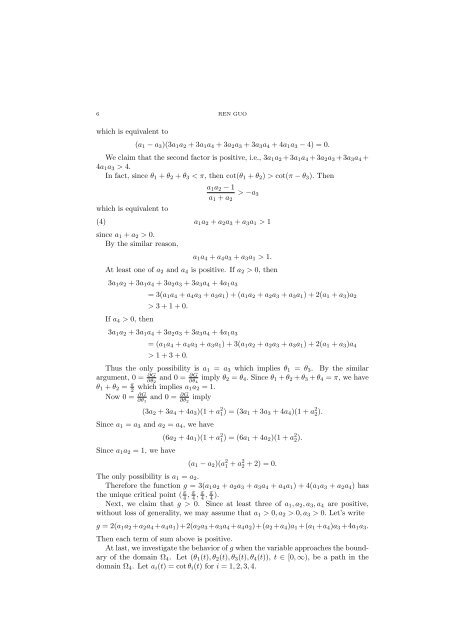Extremum problems for eigenvalues of discrete Laplace operators
Extremum problems for eigenvalues of discrete Laplace operators
Extremum problems for eigenvalues of discrete Laplace operators
You also want an ePaper? Increase the reach of your titles
YUMPU automatically turns print PDFs into web optimized ePapers that Google loves.
6 REN GUO<br />
which is equivalent to<br />
(a 1 − a 3 )(3a 1 a 2 + 3a 1 a 4 + 3a 2 a 3 + 3a 3 a 4 + 4a 1 a 3 − 4) = 0.<br />
We claim that the second factor is positive, i.e., 3a 1 a 2 +3a 1 a 4 +3a 2 a 3 +3a 3 a 4 +<br />
4a 1 a 3 > 4.<br />
In fact, since θ 1 + θ 2 + θ 3 < π, then cot(θ 1 + θ 2 ) > cot(π − θ 3 ). Then<br />
which is equivalent to<br />
(4)<br />
since a 1 + a 2 > 0.<br />
By the similar reason,<br />
a 1 a 2 − 1<br />
a 1 + a 2<br />
> −a 3<br />
a 1 a 2 + a 2 a 3 + a 3 a 1 > 1<br />
a 1 a 4 + a 4 a 3 + a 3 a 1 > 1.<br />
At least one <strong>of</strong> a 2 and a 4 is positive. If a 2 > 0, then<br />
3a 1 a 2 + 3a 1 a 4 + 3a 2 a 3 + 3a 3 a 4 + 4a 1 a 3<br />
If a 4 > 0, then<br />
= 3(a 1 a 4 + a 4 a 3 + a 3 a 1 ) + (a 1 a 2 + a 2 a 3 + a 3 a 1 ) + 2(a 1 + a 3 )a 2<br />
> 3 + 1 + 0.<br />
3a 1 a 2 + 3a 1 a 4 + 3a 2 a 3 + 3a 3 a 4 + 4a 1 a 3<br />
= (a 1 a 4 + a 4 a 3 + a 3 a 1 ) + 3(a 1 a 2 + a 2 a 3 + a 3 a 1 ) + 2(a 1 + a 3 )a 4<br />
> 1 + 3 + 0.<br />
Thus the only possibility is a 1 = a 3 which implies θ 1 = θ 3 . By the similar<br />
argument, 0 = ∂G<br />
∂θ 2<br />
and 0 = ∂G<br />
∂θ 4<br />
imply θ 2 = θ 4 . Since θ 1 + θ 2 + θ 3 + θ 4 = π, we have<br />
θ 1 + θ 2 = π 2 which implies a 1a 2 = 1.<br />
Now 0 = ∂G<br />
∂θ 1<br />
and 0 = ∂G<br />
∂θ 2<br />
imply<br />
(3a 2 + 3a 4 + 4a 3 )(1 + a 2 1) = (3a 1 + 3a 3 + 4a 4 )(1 + a 2 2).<br />
Since a 1 = a 3 and a 2 = a 4 , we have<br />
Since a 1 a 2 = 1, we have<br />
(6a 2 + 4a 1 )(1 + a 2 1) = (6a 1 + 4a 2 )(1 + a 2 2).<br />
(a 1 − a 2 )(a 2 1 + a 2 2 + 2) = 0.<br />
The only possibility is a 1 = a 2 .<br />
There<strong>for</strong>e the function g = 3(a 1 a 2 + a 2 a 3 + a 3 a 4 + a 4 a 1 ) + 4(a 1 a 3 + a 2 a 4 ) has<br />
the unique critical point ( π 4 , π 4 , π 4 , π 4 ).<br />
Next, we claim that g > 0. Since at least three <strong>of</strong> a 1 ,a 2 ,a 3 ,a 4 are positive,<br />
without loss <strong>of</strong> generality, we may assume that a 1 > 0,a 2 > 0,a 3 > 0. Let’s write<br />
g = 2(a 1 a 2 +a 2 a 4 +a 4 a 1 )+2(a 2 a 3 +a 3 a 4 +a 4 a 2 )+(a 2 +a 4 )a 1 +(a 1 +a 4 )a 3 +4a 1 a 3 .<br />
Then each term <strong>of</strong> sum above is positive.<br />
At last, we investigate the behavior <strong>of</strong> g when the variable approaches the boundary<br />
<strong>of</strong> the domain Ω 4 . Let (θ 1 (t),θ 2 (t),θ 3 (t),θ 4 (t)), t ∈ [0, ∞), be a path in the<br />
domain Ω 4 . Let a i (t) = cot θ i (t) <strong>for</strong> i = 1,2,3,4.

















